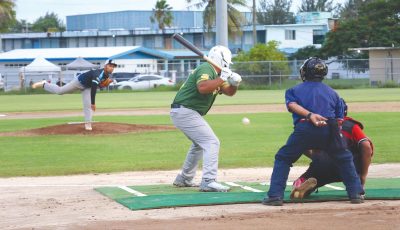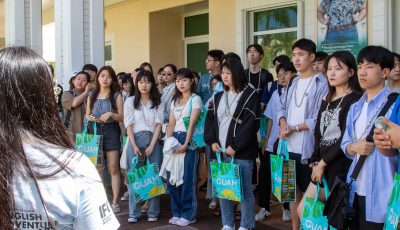UOG professor helps discover HK’s oldest maritime artifact
- An ancient Chinese anchor stock from the Song Dynasty was found submerged underwater near Basalt Island, Hong Kong. The stock was excavated in July by Dr. Bill Jeffery and the Hong Kong Underwater Heritage Group. (Contributed Photos)
- The ancient Chinese anchor stock is displayed at the Hong Kong Maritime Museum.
- Conservator Paul Harrison from the Hong Kong Maritime Museum chips away at the barnacles, rocks, and hard matter accumulated on the surface of a centuries-old 6 ft.-long cast iron British cannon which found off the coast of Hong Kong this summer.
- Dr. Bill Jeffery , first from the left, stands with staff from the Leisure and Cultural Services Department and Hong Kong maritime Museum with the ancient Chinese anchor stock.
- Back row, from left to right: Guilhem Malfre, Mr. Leung, Wai Yuen, Vincent Tong, and Jamie Yeung. Front row, from left to right: Simon Lau, Rick Chan, Bill Jeffery, Paul Harrison, and Marco Li. Members of the Hong Kong Underwater Heritage Group pose with the British cannon found in Hong Kong’s waters.
University of Guam Associate professor of Anthropology Dr. Bill Jeffery recently helped discover and excavate Hong Kong’s oldest maritime artifact—an anchor stock that dates back to China’s Song Dynasty.
Jeffery and a team of about nine local divers from Hong Kong two years ago were surveying ceramics in the eastern part of Hong Kong’s waters off the coast of Basalt Island when they stumbled upon the anchor stock—a crossbeam mounted to the top of an anchor.
Covered in barnacles, rocks, and other hard matter accumulated on the outer surface, the anchor stock dates back nearly 1,000 years and was excavated in July by Jeffery and the Hong Kong Underwater Heritage Group.
“For 2,000 years, ships would have been sailing through Hong Kong waters,” he said, rounding the southern tip of Hong Kong and sailing west into what is now called Guangzhou, which, many years ago, served as a trade hub for the surrounding areas.
Located less than two miles away from the anchor stock site and sunken beneath 40 meters of water, Jeffery and the Hong Kong Underwater Heritage Group this summer also excavated a 6 ft.-long cast iron British cannon not older than a couple hundred years, Jeffery said.
Both artifacts are now housed at the Hong Kong Maritime Museum. Jeffery hopes that with these two new discoveries, the government and people of Hong Kong will invest more resources into underwater surveys in search of ancient artifacts sitting just a few feet from the shoreline.
“Archeology doesn’t stop at the waterline,” Jeffery said, noting the cultural significance of maritime artifacts waiting to be found just below the ocean’s waves. “Not much as been done to look for or survey for materials underwater so it’s important to show Hong Kong that there are artifacts in the water. And with the techniques and sophisticated technology, it’s relatively easy to survey and excavate.”
For more on this story, visit www.uog.edu/faculty.
































